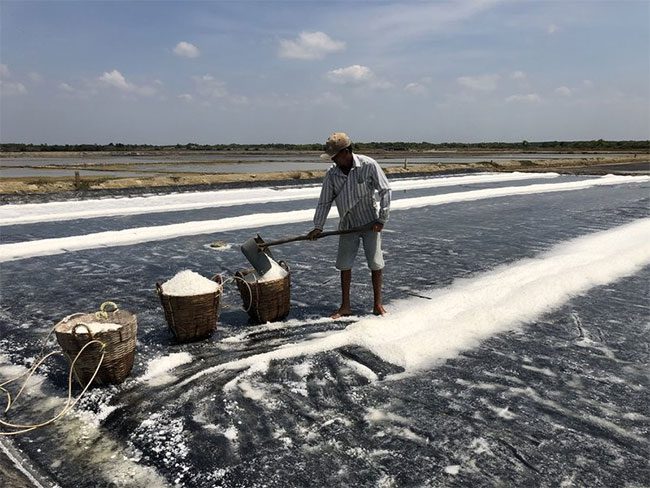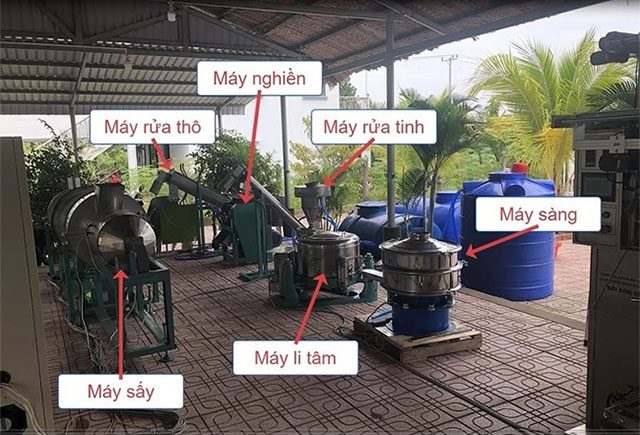Raw salt contains a high level of Calcium and Magnesium impurities, and it needs to be treated and refined before it can be used. A team of scientists has developed a simple, cost-effective treatment technology.
Removing Impurities from Raw Salt
Associate Professor Dr. Lê Thị Hồng Nhan, from the Department of Mechanical Engineering and Technology Research Center at the Ho Chi Minh City University of Technology, leads the team on “Research Proposing Technology and Equipment for Producing Refined Salt for Cần Giờ District.”
Dr. Lê Thị Hồng Nhan stated that the annual salt production in Ho Chi Minh City accounts for about 10% of the national total, concentrated in the communes of Lý Nhơn, Thạnh An, Long Hòa, and Cần Thạnh town in Cần Giờ District, with Lý Nhơn being the largest area at over 830 hectares.

Harvesting salt in Lý Nhơn Commune (Cần Giờ District, Ho Chi Minh City).
Due to outdated technology, the product is mainly raw salt, which has low NaCl content and many impurities, leading to unstable productivity. In some years, salt production in Cần Giờ reached nearly 75,000 tons, but the unstable prices and difficult consumption resulted in low economic efficiency, causing significant hardships for salt farmers.
The properties of raw salt in Cần Giờ vary depending on the harvesting location. For example, raw salt from Lý Nhơn contains more Ca-Mg impurities compared to raw salt from Thạnh An, necessitating treatment and refinement before use. According to the Vietnamese standard TCVN 3974:2015, the allowable ion content of Ca and Mg in refined salt is 0.2% and 0.25%, totaling 0.45%.
After two years of research, with strong support from Cần Giờ District and relevant agencies, the engineering and expert team at the Mechanical Engineering and Technology Research Center has developed a technology process for producing salt that meets TCVN 3974:2015 standards for the raw salt produced using water evaporation technology in Cần Giờ District.
From this technological process, a pilot production and refining line with a capacity of 100 kg/hour has also been designed and manufactured to produce refined salt that meets the aforementioned requirements.
The salt production and refining line has been designed, manufactured, and put into trial operation, consisting of seven independent modules. Each module can adjust operational parameters to suit the different raw salt sources from various communes in Cần Giờ District.
The machine modules include: rough washing, grinding, fine washing, centrifugation, drying, screening, and packaging (500 grams/package). Dr. Lê Thị Hồng Nhan noted that salt from Cần Thạnh and Lý Nhơn undergoes at least two washings to meet the refined salt standard (food salt), and the washing water can be reused for subsequent washes after applying specific settling, filtering, and neutralizing methods.
Developing Salt By-products

The “refining” salt production line installed and tested at Cần Giờ Tương Lai Cooperative.
The completed technology process for salt production and the salt production line that meets standards is a necessary demand today to support salt farmers and the salt industry of Ho Chi Minh City and the country.
Refined salt products that meet quality standards have high economic potential and are in demand in various production fields such as food, pharmaceuticals, and cosmetics. High-quality refined salt products also contribute to improving the quality of life for salt farmers.
The perfected solution has the potential to support domestic researchers in the fields of chemistry, automation, mechatronics, and processing machines, while also promoting the development of specialized machinery in the salt processing industry,” Dr. Lê Thị Hồng Nhan emphasized.
This system is entirely researched and developed domestically, allowing customization to suit the different raw salt sources from various localities.
Dr. Lê Thị Hồng Nhan proposed continuing research to enhance the automation of the salt production and refining line; to design and manufacture production lines for products from refined salt and salt by-products, such as mouthwash salt, herbal bath salt, and foot soak salt; and to design and manufacture production lines for seafood salt from raw materials sourced from Cần Giờ District.
Mr. Hồ Ngọc Thiện, Head of the Economic Department of Cần Giờ District, mentioned that the district has about 1,500 hectares of salt production with an annual output of approximately 100,000 tons.
However, the locals mainly sell raw salt, leading to very low prices. In particular, there have been years when the price of finished salt was not enough to cover labor costs, necessitating state support.
In response to this situation, Cần Giờ District has proposed to the Ho Chi Minh City Department of Science and Technology to commission research institutes to process products from raw salt to enhance the production value of the salt industry.
According to Mr. Thiện, with the salt refining line successfully completed and tested by the team of scientists from the Ho Chi Minh City University of Technology at the Cần Giờ Tương Lai Cooperative, this locality hopes that the production of refined salt will further increase the value of Cần Giờ salt.
“At the same time, through this technology, the locality hopes that the Ho Chi Minh City Department of Science and Technology will continue to support the district in commissioning technical solutions to proactively produce other products from refined salt, such as herbal salt, salt tablets for dishwashers, and other useful products to enhance the economic production value for the locality,” Mr. Thiện expressed.


















































